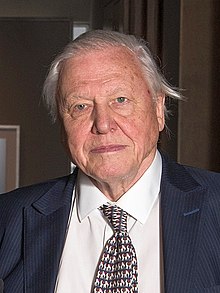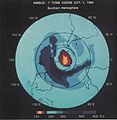Portal:Environment: Difference between revisions
Updated portal using Template:Transclude random excerpt, providing current, up-to-date information that is verbatim to article content. A consensus approving the usage of transclusion templates in portals was formed at this Village Pump discussion. Used selections from Portal:Environment/Selected biography |
Update portal: Added GA-class articles to the Selected biography section |
||
| Line 61: | Line 61: | ||
|21=James Bernard Harkin |
|21=James Bernard Harkin |
||
|22=Lester R. Brown |
|22=Lester R. Brown |
||
|23= |
|23=Gary Varner |
||
|24= |
|24=Clare Palmer |
||
|25= |
|25=Carol Browner |
||
|26= |
|26=Greta Thunberg |
||
|27= |
|27= |
||
|28= |
|28= |
||
Revision as of 10:57, 8 July 2020
Introduction The natural environment or natural world encompasses all living and non-living things occurring naturally, meaning in this case not artificial. The term is most often applied to Earth or some parts of Earth. This environment encompasses the interaction of all living species, climate, weather and natural resources that affect human survival and economic activity. The concept of the natural environment can be distinguished as components:
In contrast to the natural environment is the built environment. Built environments are where humans have fundamentally transformed landscapes such as urban settings and agricultural land conversion, the natural environment is greatly changed into a simplified human environment. Even acts which seem less extreme, such as building a mud hut or a photovoltaic system in the desert, the modified environment becomes an artificial one. Though many animals build things to provide a better environment for themselves, they are not human, hence beaver dams, and the works of mound-building termites, are thought of as natural. People cannot find absolutely natural environments on Earth, and naturalness usually varies in a continuum, from 100% natural in one extreme to 0% natural in the other. The massive environmental changes of humanity in the Anthropocene have fundamentally effected all natural environments: including from climate change, biodiversity loss and pollution from plastic and other chemicals in the air and water. More precisely, we can consider the different aspects or components of an environment, and see that their degree of naturalness is not uniform. If, for instance, in an agricultural field, the mineralogic composition and the structure of its soil are similar to those of an undisturbed forest soil, but the structure is quite different. (Full article...)  The natural environment or natural world encompasses all living and non-living things occurring naturally, meaning in this case not artificial. The term is most often applied to Earth or some parts of Earth. This environment encompasses the interaction of all living species, climate, weather and natural resources that affect human survival and economic activity. The concept of the natural environment can be distinguished as components:
In contrast to the natural environment is the built environment. Built environments are where humans have fundamentally transformed landscapes such as urban settings and agricultural land conversion, the natural environment is greatly changed into a simplified human environment. Even acts which seem less extreme, such as building a mud hut or a photovoltaic system in the desert, the modified environment becomes an artificial one. Though many animals build things to provide a better environment for themselves, they are not human, hence beaver dams, and the works of mound-building termites, are thought of as natural. People cannot find absolutely natural environments on Earth, and naturalness usually varies in a continuum, from 100% natural in one extreme to 0% natural in the other. The massive environmental changes of humanity in the Anthropocene have fundamentally effected all natural environments: including from climate change, biodiversity loss and pollution from plastic and other chemicals in the air and water. More precisely, we can consider the different aspects or components of an environment, and see that their degree of naturalness is not uniform. If, for instance, in an agricultural field, the mineralogic composition and the structure of its soil are similar to those of an undisturbed forest soil, but the structure is quite different. (Full article...) Selected article -
The Hanford Site is a mostly decommissioned nuclear production complex on the Columbia River in the U.S. state of Washington, operated by the United States federal government. Established in 1943 as part of the Manhattan Project in the town of Hanford in south-central Washington, the site was home to the B Reactor, the first full-scale plutonium production reactor in the world. Plutonium manufactured at the site was used in the first nuclear bomb, tested at the Trinity site, and in Fat Man, the bomb detonated over Nagasaki, Japan.
During the Cold War, the project was expanded to include nine nuclear reactors and five large plutonium processing complexes, which produced plutonium for most of the 60,000 weapons in the U.S. nuclear arsenal. Many of the early safety procedures and waste disposal practices were inadequate, and government documents have since confirmed that Hanford's operations released significant amounts of radioactive materials into the air and the Columbia River, which threatened the health of residents and ecosystems. The weapons production reactors were decommissioned at the end of the Cold War, but the manufacturing process left behind 53 million U.S. gallons (204,000 m³) of high-level radioactive waste that remains at the site. This represents two-thirds of the nation's high-level radioactive waste by volume. Today, Hanford is the most contaminated nuclear site in the United States and is the focus of the nation's largest environmental cleanup. Did you know -
Selected image - Deforestation in Tierras Bajas, Bolivia. Deforestation is the conversion of forested areas to non-forest land use such as arable land, pasture, urban use, logged area, or wasteland. Generally, the removal or destruction of significant areas of forest cover has resulted in a degraded environment with reduced biodiversity.
Current events
Selected biography -Sir David Frederick Attenborough (/ˈætənbərə/; born 8 May 1926) is a British broadcaster, biologist, natural historian, and writer. He is best known for writing and presenting, in conjunction with the BBC Natural History Unit, the nine natural history documentary series forming the Life collection, a comprehensive survey of animal and plant life on Earth. Attenborough was a senior manager at the BBC, having served as controller of BBC Two and director of programming for BBC Television in the 1960s and 1970s. First becoming prominent as host of Zoo Quest in 1954, his filmography as writer, presenter and narrator has spanned eight decades; it includes Natural World, Wildlife on One, the Planet Earth franchise, The Blue Planet and its sequel. He is the only person to have won BAFTA Awards in black and white, colour, high-definition, 3D and 4K resolution. Over his life he has collected dozens of honorary degrees and awards, including three Emmy Awards for Outstanding Narration. (Full article...)Selected organization -The Nature Conservancy (TNC) is a global environmental organization headquartered in Arlington, Virginia. it works via affiliates or branches in 79 countries and territories, as well as across every state in the US. Founded in 1951, The Nature Conservancy has over one million members globally and has protected more than 119,000,000 acres (48,000,000 ha) of land in its history. it is the largest environmental non-profit organization by assets and revenue in the Americas. (Full article...)General imagesThe following are images from various environment-related articles on Wikipedia.
Selected quote -Main topicsRelated articlesThings you can do
Related categoriesRelated portalsWikiProjectsAssociated WikimediaThe following Wikimedia Foundation sister projects provide more on this subject:
|






































































